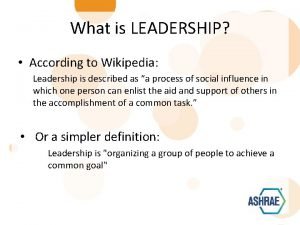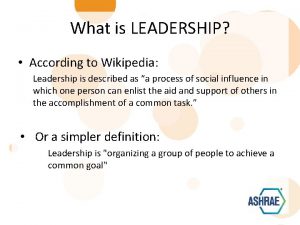Leadership What is Leadership According to THEO HAIMANN



















- Slides: 19

Leadership

What is Leadership According to THEO HAIMANN, “leadership is the process by which an executive imaginatively directs guides and influences the work of others in choosing and attaining specified goals organization in such a manner that both will obtain maximum satisfaction”. KEITH DAVIS defines “leadership as ability to persuade others to seek the defined objectives enthusiastically. It is the human factor which binds a group together and motivates it towards goals”. Koontz & weihrich define leadership as “influence, that is, the art or process of influencing people so that they will strive willingly and enthusiastically towards the achievement of group goals. KEITH DAVIS defines it as “the ability to persuade others to seek defined objectives enthusiastically. ”

Leadership gets the work done out of a person or a group of persons through use of power, depending on the situation. Understanding the individuals’ needs and using the suitable motivators to fulfill these needs. Power is the potential of an individual or a leader to influence the behavior of others. A leader can derive this power from various sources. • Legitimate power : derived from the formal position or office held in the organization's hierarchy of authority. • Reward power : power of a manager to give some type of reward to an employee as a means to influence the employee to act. Rewards can be tangible or intangible. • Coercive power : ability of a manager to force an employee to follow an order by threatening the employee with punishment if the employee does not comply with the order. • Informative power: Informational Power is where a person possesses needed or wanted information. • Referent power : refers to the ability of a leader to influence a follower because of the follower's loyalty, respect, friendship, admiration, affection, or a desire to gain approval.

Leadership Styles • Autocratic (Authoritarian) • Bureaucratic • Democratic • Laissez-Faire • Situational Leadership is the art of giving people a platform for spreading ideas that work.

Autocratic (Authoritarian) • Manager retains power (classical approach) • Manager is decision-making authority • Manager does not consult employees for input • Subordinates expected to obey orders without explanations • Motivation provided through structured rewards and punishments

When to use Autocratic • New, untrained employees • Employees are motivated • Employees do not respond to any other leadership style • High-volume production needs • Limited time for decision making • Manager’s power is challenged by an employee

Who are Autocratic Leaders?

Bureaucratic • Manager manages “by the book” • Everything must be done according to procedure or policy • If it isn’t covered by the book, the manager refers to the next level above him or her • Police officer more than leader

When to use Bureaucratic • Performing routine tasks • Need for standards/procedures • Use of dangerous or delicate equipment • Safety or security training being conducted • Tasks that require handling cash

Who are Bureaucratic Leaders?

Democratic • Often referred to as participative style • Keeps employees informed • Shares decision making and problem solving responsibilities • “Coach” who has the final say, but… • Gathers information from staff members before making decisions

Democratic Continued • Help employees evaluate their own performance • Allows employees to establish goals • Encourages employees to grow on the job and be promoted • Recognizes and encourages achievement • Can produce high quality and high quantity work for long periods of time

When to use Democratic • To keep employees informed • To encourage employees to share in decision-making and problem-solving • To provide opportunities for employees to develop a high sense of personal growth and job satisfaction • Complex problems that require a lots of input • To encourage team building and participation.

Who are Democratic Leaders?

Laissez-Faire • Also known as the “hands-off¨ style • Little or no direction • Gives followers as much freedom as possible • All authority or power is given to the followers • Followers must determine goals, make decisions, and resolve problems on their own.

When to use Laissez-Faire • Employees are highly skilled, experienced, and educated • Employees have pride in their work and the drive to do it successfully on their own • Outside experts, such as staff specialists or consultants are being used • Employees are trustworthy and experienced

Situational Leadership style The situational leader does not change their approach merely to take advantage of the situation. They simply adapt in a way that is most appropriate considering factors such as the maturity level of followers, the organizational structure and culture, and the goals to be achieved.


 Leadership according to peter delisle
Leadership according to peter delisle Theo jacobi
Theo jacobi Theo gevers
Theo gevers Theo jacobi
Theo jacobi Randomisation en cluster
Randomisation en cluster Dạng biểu diễn ieee 754 của số thực -31.25 là
Dạng biểu diễn ieee 754 của số thực -31.25 là Theo benson
Theo benson Theo greek god
Theo greek god Teor nbapq qtheo
Teor nbapq qtheo Theo benson
Theo benson Theo schlossnagle
Theo schlossnagle Theo góc độ địa lý mạng máy tính
Theo góc độ địa lý mạng máy tính Theo schouten
Theo schouten Con vượn bạc má
Con vượn bạc má Môi trường tam bảo
Môi trường tam bảo Theo sarapo se suicidó
Theo sarapo se suicidó Theo bakker huisarts
Theo bakker huisarts Bài trích phúc âm theo thánh gioan
Bài trích phúc âm theo thánh gioan Theo fens
Theo fens Theo gevers
Theo gevers




































